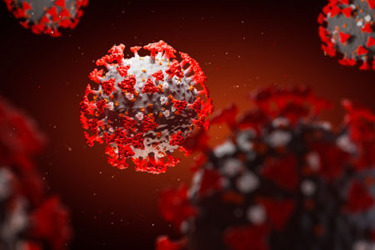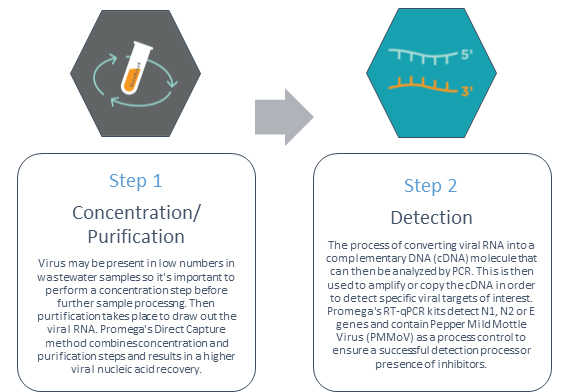Detecting COVID-19 Early Via Wastewater Surveillance
By Sameer Moorji

Wastewater-based epidemiology (WBE) is the analysis of wastewater to identify the presence of biologicals or chemicals for the purpose of monitoring public health. It can provide a snapshot of entire communities from one sample. Detecting viral diseases by way of wastewater monitoring is nothing new, it’s been known for decades that viral particles can be detected in human feces. WBE has previously been used to detect the presence of pharmaceutical or industrial waste, drugs, viruses, and potential emergence of antibiotic-resistant bacteria. In Israel, a wastewater surveillance program for monitoring polio outbreaks has been successfully running since 1989 [1].
Around the world, laboratories are now pursuing the same approach for COVID-19, hoping that the data collected from wastewater surveillance can be a useful tool in managing public health. Studies have shown that SARS-CoV-2 ribonucleic acid (RNA) can be identified in the feces of affected individuals prior to the onset of symptoms, and it is this finding that has prompted an investigation into using WBE to monitor and track the appearance and spread of COVID-19 in communities.
The Need For Wastewater Testing
Wastewater surveillance of COVID-19 represents a valuable complement to clinical approaches. On a larger scale, wastewater surveillance has the potential to provide many benefits over clinical testing as it is a low-cost, non-invasive solution to assess viral transmission rates throughout substantial populations. Instead of individually testing thousands of patients, collecting and testing a small number of wastewater samples is much more cost-efficient for obtaining population-wide data to identify infection trends.
Although clinical testing is highly effective to detect infected individuals, the expense and length of time that it takes to receive results make it challenging for public-health officials to determine infection levels quickly and even before symptoms begin. One sample of wastewater gathered from sewage plants could contain amalgamated samples of thousands of people. By continuously collecting and monitoring the viral material in these samples, there can be an indication of whether there is a spike in viral infection within that town or city.
SARS-CoV-2 RNA can be detected in human feces a few days to a week before the onset of symptoms. A study showed that sewage surveillance can predict COVID-19 outbreaks even before individual patient testing and hospital admissions [2]. Based on this initial SARS-CoV-2 wastewater testing, officials can then perform further clinical testing or quarantine those at high-risk without affecting the entire population to avoid large outbreaks. The success in revealing infection dynamics earlier than diagnostic testing could provide almost real-time information on disease prevalence.
Another benefit over clinical testing is the reduction of bias. The majority of individuals who take a test are those who are already symptomatic and the inability to track asymptomatic disease carriers doesn’t give a clear picture of infection rates. Wastewater surveillance takes a snapshot of the entire community, the healthy and the sick, to provide reliable and accurate data. Schools and universities are great candidates for this type of testing because they have large populations and benefit from an early warning of possible outbreaks.
Method Development For Wastewater Monitoring
As the COVID-19 restrictions started to lift, many colleges and universities had to make the difficult decision of whether to bring back students and staff for face-to-face teaching or continue online classes. With students often living together in close proximity in dormitories, an outbreak could quickly get out of hand. With the help of wastewater surveillance, the university or school would be able to monitor and control the spread of the virus to ensure everyone’s safety.
Researchers at Microbac Laboratories in Oak Ridge, TN, were contacted by several universities in 2020 to undertake such testing. Microbac is a network of privately owned laboratories with 50 years’ experience of analytical testing services for food products, environmental samples, and the life science industry and an established a reputation for taking on difficult problems.
To perform tests on wastewater samples, some labs initially started using a standard clinical Quantitative Polymerase Chain Reaction (qPCR) but it was soon clear that more was required to address the complexities of the wastewater sample type. The internal controls in clinical testing kits were meant for human samples, not wastewater and to ensure accurate results, a kit specifically designed for wastewater was needed. A challenge arose to develop a method for SARS-CoV-2 wastewater testing.
Many suppliers only provided kits for detecting multiple regions of SARS-CoV-2, whereas testing labs such as Microbac needed individual kits for each target separately, including nucleocapsid gene (N) 1 or 2 and envelope gene (E), to give researchers the flexibility they required. The result was a PCR kit (SARS-CoV-2 RT-qPCR Kit for Wastewater, Promega) specifically for detecting viral RNA in wastewater with multiple internal controls, taking into account all the different parameters that need to be monitored.
The SARS-CoV-2 wastewater samples are tested using the Reverse Transcription (RT)-qPCR method shown in Figure 1 below.

Figure 1 - the RT-PCR method. [3]
Looking To The Future
The idea of using wastewater surveillance to monitor COVID-19 long-term has now been accepted globally, helping communities to return to a new type of normal, however it is still an emerging field. In March 2021, the European Commission recommended that all member countries put in place a national wastewater surveillance system as soon as possible [4] to help prevent outbreaks and slow the spread of the virus. The methods developed for testing SARS-CoV-2 will be useful for testing other pathogens in the future. The protocols put in place and the lessons learned during the COVID-19 pandemic have laid the foundation for this important public health tool in managing future disease outbreaks.
About Promega Corporation
Promega Corporation is a leader in providing innovative solutions and technical support to the life sciences industry. Our product portfolio of over 4,000 products support a range of life science work across areas such as cell biology; DNA, RNA and protein analysis; drug development; human identification and molecular diagnostics. For over 40 years these tools and technologies have grown in their application and are used today by scientists and technicians in labs for academic and government research, forensics, pharmaceuticals, clinical diagnostics, and agricultural and environmental testing. Promega is headquartered in Madison, WI, USA with branches in 16 countries and over 50 global distributors. For more information, visit www.promega.com.
References
[1] A. F. Brouwer, J. N. S. Eisenberg, C. D. Pomeroy, L. M. Shulman, M. Hindiyeh, Y. Manor, I. Grotto, J. S. Koopman and M. C. Eisenberg, "Epidemiology of the silent polio outbreak in Rahat, Israel, based on modeling of environmental surveillance data," Proceedings of the National Academy of Sciences, vol. 115, no. 45, 18 October 2018.
[2] J. Peccia, A. Zulli, D. E. Brackney, N. D. Grubaugh, E. H. Kaplan, A. Casanovas-Massana, A. I. Ko, A. A. Malik, D. Wang, M. Wang, J. L. Warren, D. M. Weinberger and S. B. Omer, "SARS-CoV-2 RNA concentrations in primary municipal sewage sludge as a leading indicator of COVID-19 outbreak dynamics," medRxiv, May 19 2020.
[3] Microbac, "SARS-CoV-2 Wastewater Test," 2021. [Online]. Available: https://www.microbac.com/sarscov2-wastewater-test. [Accessed 15 September 2021].
[4] EU Commission, "Document 32021H0472," 19 March 2021. [Online]. Available: https://eur-lex.europa.eu/eli/reco/2021/472/oj. [Accessed 15 September 2021].
 Sameer Moorji is the Director of Applied Markets Business Unit at Promega Corporation. His team is responsible for the strategic direction and commercialization of differentiating technologies to serve the needs of customers in environmental, agricultural, food, and veterinary sciences. Most recently, the team developed a simple and sensitive workflow solution for detecting SARS-CoV-2 in wastewater that is now used by testing labs globally.
Sameer Moorji is the Director of Applied Markets Business Unit at Promega Corporation. His team is responsible for the strategic direction and commercialization of differentiating technologies to serve the needs of customers in environmental, agricultural, food, and veterinary sciences. Most recently, the team developed a simple and sensitive workflow solution for detecting SARS-CoV-2 in wastewater that is now used by testing labs globally.
